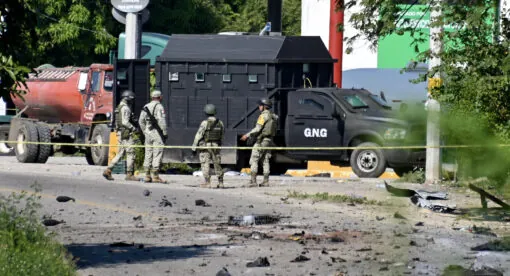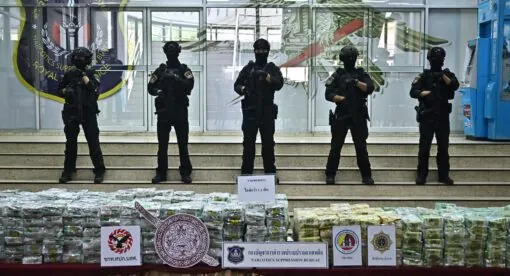The explosive rise of Southeast Asia-based scam networks targeting victims globally is no accident; it is the byproduct of China’s vast offshore shadow liquidity systems. Scammers from the region have increasingly targeted victims in the United States, who lost at least $5 billion to such scams in 2024 alone. Scam hubs, some of which comprise entire cities built using offshored Chinese wealth, threaten stability across Asia by draining middle-class savings into a self-perpetuating parasitic ecosystem. These criminal enterprises are now actively expanding their operations in Africa and Latin America, positioning themselves closer to Western societies where aging populations are especially vulnerable to sophisticated cybercrimes. These systems also threaten regional stability, with recent military clashes between Thailand and Cambodia underpinned by rising scam activity and capital flows to the Cambodian side of their disputed border.
Over the past decade, China built a secret offshore capital reservoir to shield itself from an increasingly hostile outside world. That reservoir, combined with massive capital outflows, has spawned a vast criminal ecosystem that threatens social and economic interests the world over. Moreover, the networks constituting this ecosystem now serve their own ends, not merely those of Beijing. In the absence of safeguards, this pooled liquidity has fueled criminality that now threatens China despite Beijing’s ongoing efforts to reassert control over it. This offshored criminal ecosystem demonstrates a fundamental truth by its very existence: liquidity systems, once externalized beyond state oversight, become self-reinforcing, corrosive infrastructures.
In Southeast Asia, sprawling scam hubs now siphon an estimated tens of billions of dollars or more annually, turning a defensive buffer into a parasitic financial ecosystem threatening regional and global stability. This criminal ecosystem exposes a significant contradiction at the heart of China’s model: a regime built on centralized control increasingly entangled with systems it can neither regulate nor contain. These networks – once designed to strengthen China’s financial sovereignty – now threaten it, eroding domestic stability and undermining the very narrative of control the ruling Communist Party depends on to maintain legitimacy.
What Is Shadow Liquidity?
Shadow liquidity is a mobile layer of capital that exists outside standard regulatory frameworks. Unlike traditional illicit finance, which is explicitly criminal, it occupies a gray zone – part statecraft tool, part private escape valve, part opportunistic exploitation. Its core function is not to hide individual transactions but to maintain a resilient flow of value that can shift jurisdictions, instruments, or ownership structures as conditions demand.
China’s offshore liquidity systems emerged as a response to external pressures, including tariffs and sanctions. Initially structured as discreet channels to support trade and investment, these reserves evolved into conduits for elite capital flight and informal influence operations. A clear example is the $900 billion in offshore foreign currency assets held by China’s state commercial banks, funded by deposits made by state-owned enterprises and outside the official People’s Bank of China (PBoC) balance sheet. Designed as a buffer against external shocks, these pools of liquidity coincide with the rise of informal networks beyond Beijing’s direct control.
DeepSeek, an artificial intelligence product developed in close proximity to China’s state-owned military and defense sector, provided a striking example of how offshore liquidity pools serve Chinese state interests. In June 2025, U.S. officials accused DeepSeek’s parent company of using shell corporations in Southeast Asia to acquire banned Nvidia H100 chips – critical for training advanced AI models – thereby bypassing sanctions aimed at curbing Beijing’s military AI ambitions. Recent cases also show that Chinese firms leverage offshore entities to evade recently escalated U.S. tariffs. In this way, these networks created a parallel reservoir of liquidity designed to move outside Beijing’s formal financial architecture while remaining at least partly aligned with state objectives.
However, by unleashing vast sums of liquidity into loosely regulated financial systems, Beijing seeded a landscape where state-linked capital, private wealth, and criminal enterprise converge. According to a July 2025 report from the U.S.–China Economic and Security Review Commission (USCC), Chinese criminal networks in Southeast Asia “have built ties – some overt, some deniable – to the Chinese government by embracing patriotic rhetoric and supporting China’s Belt and Road Initiative (BRI).” The report further notes that “Chinese crime syndicates have expanded across the region with, at a minimum, implicit financial and political backing from elements of the Chinese government.” Murky state-linked investments in now-notorious scam hubs like the Golden Triangle Special Economic Zone (SEZ) in Laos and Myanmar’s Shwe Kokko SEZ are just some examples. What was meant to be a controlled instrument of resilience has instead become a porous, adaptive ecosystem – one increasingly beyond Beijing’s ability to discipline without destabilizing the very flows it relies on.
In China’s case, offshored “shadow reserves” have become a critical funding source for BRI projects, with state commercial banks channeling offshore foreign currency assets – often absent from official PBoC reporting – into overseas infrastructure. BRI has become the most visible expression of how shadow liquidity can be weaponized as both an economic and geopolitical instrument.
Because liquidity is inherently dynamic, these networks behave less like pipelines and more like living infrastructure. They adapt under enforcement pressure, migrate during crises, and often move faster than formal financial reforms can catch them. For China, this networked capital is both a pillar of external influence and a source of internal fragility: a system built to shield the state from outside constraint that has instead created an informal architecture of power – one Beijing now depends on but cannot fully control. Simultaneously, this informal architecture has proved resilient against Chinese and other global crackdowns, likely at least in part due to its entrenchment in Chinese elite power structures.
The Southeast Asia Inflection Point
In Southeast Asia, China’s shadow liquidity strategy has mutated into something far more volatile. Scam compounds in Cambodia, Laos, and Myanmar, sprawling online gambling hubs in the Philippines, and a dense web of informal crypto-asset brokers now act as powerful magnets for Chinese capital outflows. Funds slip past Beijing’s formal controls through domestic underground banking networks, gray-market over-the-counter (OTC) brokers based in Hong Kong, and payment platforms such as Huione and other similar underground systems. These actors often facilitate capital flight disguised as trade settlement or investment outflows, converging powerfully with state-led outflows.
Investigations have tracked billions of dollars flowing through OTC desks in Bangkok and Ho Chi Minh City into scam operations and laundering networks. What began as pass-throughs for capital flight is now self-reinforcing. Reports indicate that Chinese middle-class investors have lost tens of billions of dollars to newer forms of crypto fraud – particularly pig-butchering scams – often facilitated by border OTC networks in Southeast Asia. According to Wired, global losses due to scam operations exceeded $75 billion in 2023, with China-origin capital feeding scam compounds and high-risk gambling zones in Cambodia, Laos, Myanmar, and beyond. These systems no longer route funds back into China; they feed their own expansion, siphoning ever-larger volumes of Chinese wealth to sustain illicit economies.
This dynamic has created a parasitic financial architecture. Chinese liquidity designed to circumvent external constraints is now trapped in feedback loops, comingling with and empowering nonstate actors and criminal organizations. For example, the Yemen-based al-Houthi rebel group has used Huione to transfer $39 million in illicit proceeds. Militant groups in Myanmar have been linked to similar funding schemes. These networks have proven resilient in the face of global pressure, such as recent revelations that Huione remains operational despite its formal shutdown in the wake of U.S. sanctions.
Scam centers now threaten regional stability in Southeast Asia, draining middle-class savings while embedding themselves into the broader gray-zone economy. For example, ethnic Chinese-run scam centers in Cambodia routinely target middle-class victims in neighboring Thailand. Thai authorities report that since 2022, these operations have defrauded domestic investors of roughly 80 billion baht (about $2.5 billion), while regional estimates variably suggest the industry now generates nearly tens of billions of dollars annually. These scam centers became an important point of tension between Thailand and Cambodia in the months leading up to the July border clashes between the two countries that killed at least 35 people and displaced more than 260,000.
The result of China’s shadow liquidity outflows is a network that serves state, private, and criminal interests simultaneously – but answers fully to none. In this Southeast Asian crucible, China’s shadow liquidity has crossed an inflection point: from strategic tool to autonomous ecosystem, eroding the very stability it was meant to secure.
How It Backfires on China
The explosion of scam-driven liquidity drains in Southeast Asia produces visible social and economic consequences inside China. Hundreds of thousands – possibly millions – of Chinese citizens have lost savings to cross-border fraud schemes linked to scam compounds and gray-market payment platforms. While reliable data on those losses is scarce, early documented cases point to hundreds of millions of dollars stolen through pigbutchering scams – long con frauds where perpetrators groom victims online before convincing them to hand over large sums of money. Today, estimates claim scam compounds generate tens of billions of dollars annually, most extracted from Chinese households – an ongoing bleed of domestic savings that represents a vastly underestimated long-term erosion of national capital.
This state-facilitated ecosystem has bred distrust within China’s middle class – the demographic Beijing relies on most for social stability. Recent unemployment and failed investments have fueled unrest and rising violence – potential harbingers of things to come as scam losses mount. The scale of loss from cross-border scams is not merely individual but systemic. As illicit networks siphon billions annually, they erode China’s internal capital coherence – the ability of the state to direct domestic savings into strategic investment. Instead of reinforcing national resilience, these shadow channels are diverting household wealth into offshore criminal ecosystems that recycle capital outside Beijing’s control.
Although Chinese authorities have made efforts at cross-border crackdowns, Southeast Asia’s scam economy continues to flourish. It is likely that Beijing cannot fully disavow these operations due to how embedded they have become within elite circles. For example, organized crime figures such as the 14K Triad’s Wan Kuok Koi (aka “Broken Tooth”) reportedly hold close political ties to the Chinese Communist Party (CCP), with Wan allegedly stating that although he used to fight for the cartels, he now fights for the CCP. In 2018, Wan launched the World Hongmen History and Cultural Association, an entity U.S. authorities sanctioned two years later for its alleged criminal activity, including close ties to Southeast Asian scam operations. Washington also claims that Wan is a senior member of the Chinese government, holding a position on the Chinese People’s Political Consultative Conference – an assertion Beijing denies.
Another Chinese gangster, Zhao Wei, has benefited from extensive BRI investment in his Laos-based Golden Triangle SEZ, where he owns and operates the infamous Kings Romans Casino, which allegedly maintains extensive ties to scam operations in the SEZ. Such cases indicate that the Chinese regime maintains deep ties to the very scam operations that consistently undermine its public image despite attempts to rein them in. As ensuring capital outflows likely plays a key role in maintaining loyalty within the CCP’s opaque patronage networks, these scam operations may benefit from protection by the very officials meant to regulate them.
This dynamic sharply inverts the original aim of China’s offshore liquidity systems. What began as an effort to secure financial sovereignty and shield the economy from external shocks has instead produced an internal liquidity leak. It undermines the narrative of centralized control – the cornerstone of party legitimacy – as the population sees their own savings flow into unregulated, foreign-run criminal networks backed by state-led investments. In this way, the social cost of shadow liquidity is not just economic dislocation but also the corrosion of the trust Beijing needs to sustain its model of governance.
Policy and Security Implications
Current anti-money laundering and counter-terrorist financing frameworks focus on shadow liquidity as a criminal threat on a case-by-case basis rather than a systemic one. Compliance systems emphasize wallet-level monitoring and red-flag thresholds, but as the Financial Action Task Force (FATF) warns, the decentralization of financial operations “may further complicate efforts to disrupt larger financial networks.”
There is a clear imperative for disrupting and dismantling these shadow liquidity systems. The human cost is already visible – from human trafficking rings sustaining scam operations to the growing number of victims in the United States and globally whose wealth is funneled into opaque offshore corridors. With Western populations aging, Chinese illicit financial infrastructure already embedded within Western societies, and scam centers expanding into geographically, linguistically, and culturally proximate regions such as Africa and Latin America, the risk of a structurally entrenched global scam economy is rising. Evidence that these same corridors are exploited by terrorist and militant groups such as the Houthis to launder and transfer funds beyond the reach of traditional enforcement only underscores the urgency for decisive action.
At the state level, China’s BRI has become a dual-use platform – advancing Beijing’s geopolitical objectives while quietly facilitating elite capital flight and enabling shadow liquidity systems under the cover of infrastructure investment. In this way, BRI simultaneously spreads and undermines Beijing’s influence globally but doubly harms U.S. and other global interests by simultaneously furthering Chinese military expansionism while enabling parasitic organized criminal infrastructure. Until Beijing demonstrates a genuine commitment to dismantling these offshore shadow liquidity networks, global regulators and enforcement agencies should treat its financial initiatives with maximum caution.
Scam compounds, OTC desks, and gray-market payment networks are no longer discrete criminal enterprises; they are embedded in shadow capital infrastructure originally tied to Chinese state objectives. Treating them as isolated criminal enterprises misses their role as autonomous reservoirs of capital capable of sustaining proxy influence and destabilizing economies.
Addressing this requires ecosystem-level targeting. FATF’s 2025 report highlight “Operation Grafos,” where real-time intelligence sharing, blockchain analysis, and cross-jurisdictional coordination was employed to disrupt a virtual asset-based terrorism finance network. Those methods must become standard practice, not isolated cases.
Hybrid threat frameworks must integrate liquidity analysis alongside kinetic and cyber domains. The Basel Framework’s network-based supervision and the Organization for Economic Cooperation and Development’s beneficial ownership models offer practical templates for this. Pressure on Southeast Asian jurisdictions hosting scam enclaves must also escalate. Cambodia, Laos, Myanmar, and the Philippines are now structural nodes; carrot-and-stick approaches could force structural change.
Stablecoin and OTC-specific controls are essential. Hong Kong’s virtual asset service provider OTC regime and International Monetary Fund guidance on stablecoin flows provide blueprints for containing these pipelines. The recent announcement that stablecoin issuer Tether will fully comply with Washington’s Guiding and Establishing National Innovation for U.S. Stablecoins (GENIUS) Act over a period of 36 months is a positive step in this direction. Without systemic measures to regulate and contain these flows, shadow liquidity will continue to metastasize beyond state control, embedding itself as a structural layer of global capital flows. Given the primacy of U.S. regulatory and enforcement bodies in the global financial system, Washington will have to anchor any serious effort to contain these high-risk and unregulated flows.
By mapping these flows as an ecosystem rather than isolated incidents, enforcement bodies can identify structural chokepoints where targeted interventions may have disproportionate disruptive impact.
Conclusion
Shadow liquidity is more than a byproduct of illicit finance; it is a strategic architecture. China’s experience shows how systems built to project resilience can evolve into autonomous networks draining wealth and feeding actors beyond state control.
This is the central warning: once liquidity is externalized into unregulated systems, it no longer necessarily serves the state or actor that created it. Financial sovereignty is not just reserves; it depends on controlling the conduits of trust – the pathways through which value moves. Without discipline over these flows, even the most carefully engineered financial architecture can become a vector of decay, eroding the very stability it was built to secure. The real question is whether these systems can be contained in time – before they permanently erode the foundations of the global financial order.
The views expressed in this article are those of the author and not an official policy or position of New Lines Institute.






